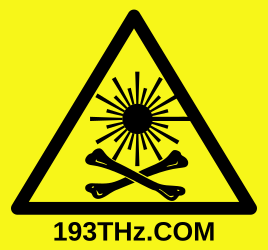
June 2023
Hydrogen cyanide has many absorption lines that can serve as wavelength references for lasers around 1550nm, and easy-to-use cells are specified in NIST SRM 2519a and available commercially at reasonable prices from Wavelength References Inc. While hydrogen cyanide may sound scary at first, the minuscule amount contained in those cells make them completely safe to handle, even if the glass envelope is broken.
Using those cells, it is possible to exploit the dependency of laser frequency on the diode current (often called "chirp" and unwanted in telecom systems) to make a very simple and inexpensive demonstrator of the basic technique of FM spectroscopy. A Eudyna FLD5F15CX-H DFB was connected to a function generator with a series resistor, programmed to output a small sine wave with a large DC offset. The output fiber is connected to the HCN cell, followed by a photodiode going into an oscilloscope channel. Another oscilloscope channel monitors the voltage at the output of the function generator. The TEC of the Eudyna laser was connected to a lab power supply and allows larger changes of the laser wavelength in order to scan over the HCN absorption lines.
The result of the laser scanning over a spectroscopic line is shown on this oscilloscope picture. The purple trace is the laser offset voltage and the yellow trace is the photodiode voltage. It can be clearly seen that the phase between the signals reverses as the spectroscopic line is crossed, which is the key feature of FM spectroscopy. The amplitude also changes as the spectroscopy signal interferes constructively or destructively with the large amounts of laser amplitude modulation present.
There are certainly better ways to perform FM spectroscopy, in particular with a view to reducing the large amounts of laser amplitude modulation, but this is probably the simplest setup that would possibly work. It is interesting to note that a DWDM SFP basically contains all the required components to do this (except the HCN cell of course). Those SFPs contain a microcontroller, often with a publically available datasheet, which is normally used to perform laser temperature stabilization and housekeeping functions such as diagnostics over the I2C bus. It could in theory be reprogrammed to run the show, with simple hardware modifications to the SFP to reduce the modulation depth of its laser driver and to reroute the TX and RX signals to the microcontroller. This could make for a very compact and low-cost laser with high absolute wavelength accuracy. If you attempt this, do let me know :)
Update (January 2025): For something really cheap, you should consider a red laser diode and a neon indicator lamp instead.